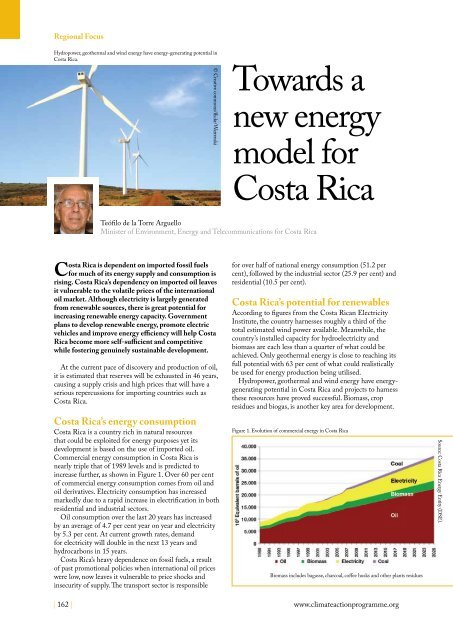Climate Action 2010-2011
Create successful ePaper yourself
Turn your PDF publications into a flip-book with our unique Google optimized e-Paper software.
Regional Focus<br />
Hydropower, geothermal and wind energy have energy-generating potential in<br />
Costa Rica.<br />
© Creative commons/flickr/Warrenski<br />
Towards a<br />
new energy<br />
model for<br />
Costa Rica<br />
Teófilo de la Torre Arguello<br />
Minister of Environment, Energy and Telecommunications for Costa Rica<br />
Costa Rica is dependent on imported fossil fuels<br />
for much of its energy supply and consumption is<br />
rising. Costa Rica’s dependency on imported oil leaves<br />
it vulnerable to the volatile prices of the international<br />
oil market. Although electricity is largely generated<br />
from renewable sources, there is great potential for<br />
increasing renewable energy capacity. Government<br />
plans to develop renewable energy, promote electric<br />
vehicles and improve energy efficiency will help Costa<br />
Rica become more self-sufficient and competitive<br />
while fostering genuinely sustainable development.<br />
At the current pace of discovery and production of oil,<br />
it is estimated that reserves will be exhausted in 46 years,<br />
causing a supply crisis and high prices that will have a<br />
serious repercussions for importing countries such as<br />
Costa Rica.<br />
Costa Rica’s energy consumption<br />
Costa Rica is a country rich in natural resources<br />
that could be exploited for energy purposes yet its<br />
development is based on the use of imported oil.<br />
Commercial energy consumption in Costa Rica is<br />
nearly triple that of 1989 levels and is predicted to<br />
increase further, as shown in Figure 1. Over 60 per cent<br />
of commercial energy consumption comes from oil and<br />
oil derivatives. Electricity consumption has increased<br />
markedly due to a rapid increase in electrification in both<br />
residential and industrial sectors.<br />
Oil consumption over the last 20 years has increased<br />
by an average of 4.7 per cent year on year and electricity<br />
by 5.3 per cent. At current growth rates, demand<br />
for electricity will double in the next 13 years and<br />
hydrocarbons in 15 years.<br />
Costa Rica’s heavy dependence on fossil fuels, a result<br />
of past promotional policies when international oil prices<br />
were low, now leaves it vulnerable to price shocks and<br />
insecurity of supply. The transport sector is responsible<br />
| 162 |<br />
for over half of national energy consumption (51.2 per<br />
cent), followed by the industrial sector (25.9 per cent) and<br />
residential (10.5 per cent).<br />
Costa Rica’s potential for renewables<br />
According to figures from the Costa Rican Electricity<br />
Institute, the country harnesses roughly a third of the<br />
total estimated wind power available. Meanwhile, the<br />
country’s installed capacity for hydroelectricity and<br />
biomass are each less than a quarter of what could be<br />
achieved. Only geothermal energy is close to reaching its<br />
full potential with 63 per cent of what could realistically<br />
be used for energy production being utilised.<br />
Hydropower, geothermal and wind energy have energygenerating<br />
potential in Costa Rica and projects to harness<br />
these resources have proved successful. Biomass, crop<br />
residues and biogas, is another key area for development.<br />
Figure 1. Evolution of commercial energy in Costa Rica<br />
Biomass includes bagasse, charcoal, coffee husks and other plants residues<br />
www.climateactionprogramme.org<br />
Source: Costa Rica Energy Entity (DSE).












